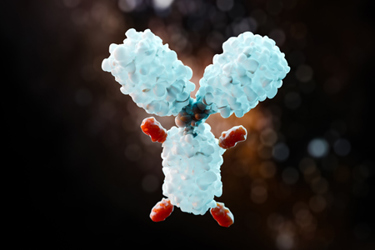ADCs: Leading With The Linker

By Matthew Pillar, Editor, Bioprocess Online

My first point of intrigue upon meeting Leo Marx, Ph.D., the Medicinal Chemistry Project and Bioconjugation Manager at Debiopharm, was the latter part of his title.
In this fast-evolving age of double- and triple- and quadruple-stacked biologic therapeutic development, it strikes me that bioconjugation expertise is in the highest of demand. “My initial role here was to develop new linker technology, and now I’m focused on applying that technology to the discovery of new ADCs through bio-conjugation and cytotoxic payload design and synthesis,” he tells me.
That new linker technology is Debiopharm’s Multilink, a peptidic cleavable linker platform suited for multidrug attachment and compatible with any conjugation technology to produce stable ADCs with high DAR (drug-to-antibody ratio). The cathepsin B-cleavable differs from traditional approaches in its mechanistic action. The exopeptidase activity of cathapsin B, says Marx, renders Debiopharm’s link very selective, resulting in rapid cleavage to release the payloads once the ADC is internalized in the cell.

Marx walked me through the process development strategies at Debiopharm in the context of this unique approach, whereby the linker technology, not the antibody or its payload, is the primary driver of innovation.
COMMITTING TO ADC PROCESS DEVELOPMENT
Debiopharm’s search and evaluation team does its work with a specific intent to identify antibodies that contribute to the company’s focus on unmet medical needs, particularly in oncology, with an emphasis on tumor-specific targets. When a fitting antibody enters the Debiopharm ecosystem, the process development work begins.
Early on in that process, Marx and his team select the best linker-payload combinations to suit the antibody. “Stability and monomeric purity are key aspects of early ADC process development,” he says. “You don’t want to have to resort to formulation efforts to address aggregation of your protein during the manufacturing step and beyond into fill/finish. Your ADCs should not aggregate or conjugate in a simple buffer,” he says.
The careful matchup of payload to antibody, Marx says, is fundamental to ensuring stability from the outset. “Aggregation is mostly driven by lipophilicity of your ADCs, so if you’re beginning with a lipophilic antibody, it’s quite complicated from the start.” Thus, he and his team seek geophilic antibodies as their foundation. The payload, on the other hand, is always lipophilic. In a high-capacity payload environment like Debiopharm, lipophilicity is thus inherent, a challenge Marx and his team meet with the leading edge of their value proposition: the novel linker. He says. “We have a few strategies in our ADC building toolbox to address this. Identifying lipophilic compounds and understanding aggregation tendencies requires close examination during the analytical characterization of ADCs.”
These early optimization efforts aren’t exercised solely in the vein of improving manufacturability – they have therapeutic consequences as well. “High lipophilicity is linked to poor in vivo properties, because if you compound these 2 lipophilic entities, you can enable a specific uptake into cells that do not express your receptor, which can lead to tox issues or, at a minimum, poor PK (pharmacokinetics) of your compound.”
ADC TECH TRANSFER AND BEYOND
In addition to those research collaboration and analytical methods responsibilities, Marx oversees the supply of development materials through the candidate nomination phase. Then, he’s involved in the transfer of the technology to the Debiopharm CMC department. There, its in-house drug manufacturing facilities are equipped for small-scale ADC production for early-stage research and preclinical development. That facility boasts highly contained environments and isolators to handle toxic payload materials safely. For larger-scale production to facilitate DRF (dose range finding), GMP toxicity studies, and Phase 1 trials, manufacturing is outsourced to specialized CDMOs.
The “specialized” part of the CDMOs it partners with include the ability to handle linker and payload manufacturing, antibody production, and final conjugation and drug product formulation under one roof. “The advantage of working with such partners, independently of the geographical region, is to streamline logistics by simplifying the supply chain, which helps us tighten up our development timelines on these complex ADCs,” he says.
CDMO capacity for ADCs, says Marx, is responding to market demand. He attended the World ADC conference in San Diego this past November, and he acknowledged that year-over-year, there are more advanced outsourced manufacturing partners capable of end-to-end ADC development and manufacturing at the event. He also noted an uptick in the number of formal collaborations and partnerships among those that don’t offer full-suite ADC services within their own four walls.
FUTURE CHALLENGES, OPPORTUNITIES FOR THE ADC
Marx says that despite recent advances in ADC development and linker technology, there’s plenty of room for improvement. Most ADCs, he says, rely on a limited range of payload types, which poses challenges for long-term differentiation and resistance management. “At the moment, there are 20 active targets among the dozen-or-so approved ADCs,” he says. In fact, he says the 500+ active ADC clinical programs in the space rely on just two classes of payload — topoisomerase and inhibitors. “There's diversity of targets, but on the payload side there isn't so much to offer, which could result in resistance in patients that have received several rounds of treatment using the same classes of active drug.” That’s a difficult problem to address from a business standpoint, because risk-averse companies tend to favor validated payloads and targets. Solving it, he says, will require courageous investment.
For its part, Debiopharm is contributing to the cause by expanding its ADC pipeline, including the exploration of bispecific ADCs and novel linker-payload combinations. Clinical trials of its proprietary AML candidate, Debio 1562M, are expected to commence soon, a milestone Marx views as critical to validating the company’s linker technology and conjugation effort.
